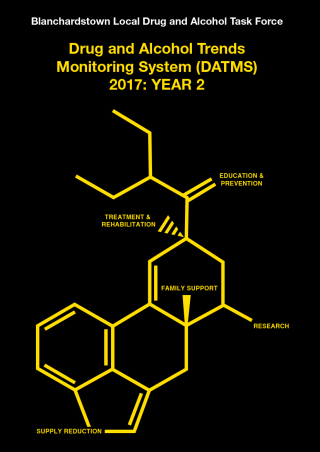
Research objectives & method
In 2015 we developed our DATMS in Dublin 15. The objective was to establish a comprehensive evidence base for drug use and misuse in Dublin 15 and use this data to inform local service provision. In order to always have current information and to monitor changes over time the study is repeated annually. We published the first report in 2016 (DATMS Year 1) and this report documents the second year of our DATMS (DATMS Year 2). The DATMS was designed to identify new emerging trends in patterns of drug use; three or more years of data are required in order to verify emerging trends. Therefore, any changes identified in this report require further investigation in subsequent DATMS data collection phases. The DATMS employs a mixed-method design comprised of primary and secondary data sources.
Summary findings
Treated drug use
- Treated drug use in Dublin 15 is increasing.
- The number of drug users aged under 18 and aged 35 and over in treatment is increasing.
- The number of Irish and non-Irish drug users in treatment is increasing.
- The number of Irish Traveller drug users in treatment is decreasing.
- Cannabis, alcohol, cocaine powder and benzodiazepines/z-drugs are the biggest problem for drug users aged under 18; the use of these drugs is increasing among this age group.
- Heroin, cannabis, alcohol, cocaine powder, benzodiazepines/z-drugs and methadone are the biggest problem for adult drug users.
- Heroin users are getting older, with few young people treated for this drug.
- The use of the following drugs is increasing among adult drug users: alcohol, cannabis, benzodiazepines/z drugs, powder and crack cocaine, lyrica and oxycodone.
- Polydrug use is the norm for the majority of treated drug users.
- Steroids and skin tanning drugs are creating new hazards in Dublin 15.
Untreated drug use
- Alcohol, cannabis, MDMA, cocaine powder and ketamine are the main drugs of use for untreated under 18 and adult drug users.
- Cocaine powder use is increasing among untreated under 18 and adult drug users.
- Cannabis resin use is increasing among Irish Traveller untreated drug users.
- Polydrug use is the norm for untreated under 18 and adult drug users; alcohol is an integral part of polydrug use.
- Drugs are mostly used at the weekend and the frequency of use is age dependent, with adults reporting more regular use.
Factors contributing to drug use
- Drugs and alcohol are easily accessed in Dublin 15:
- Alcohol, benzodiazepines/z drugs, cannabis resin, lyrica and oxycodone are increasing in availability.
- The internet continues to facilitate drug distribution and the darknet is a factor in availability.
- Drug use is normalised among some peer, family and work groups:
- A common perception is that drugs are widely used and risk free.
- The family context:
- Children’s education is being compromised by parental drug use.
- Some drug use in Dublin 15 is inter-generational.
Consequences of drug and alcohol use
- Mental health:
- Mental health disorders among treated adult drug users are increasing.
- Mental health disorders among under 18s in Dublin 15 are increasing.
- Drug-related crime:
- Drug dealers are getting younger and dealing occurs in schools.
- Drug debt intimidation continues to be an issue for young people and adults.
- Social consequences:
- Homelessness and poverty are increasing among drug users.
- Drug use in schools is increasing and causing greater damage to education and leading to more exclusions.
- Due to these social consequences rehabilitation is getting harder.
Drug litter
- Drug litter is widespread throughout Dublin 15.
- Largest concentrations of drug litter outside areas traditionally associated with drug use, indicating many more drug users than are using services.
- Most drug litter relates to untreated drug use.
- Drugs are being used in hidden and inaccessible sites, increasing the hazards associated with drug use; many hidden sites are well developed and regularly used.
Gaps in service provision identified by research participants
- Access to mental health services is not improving, especially for young people.
- The prescribing of addictive medication requires regulation.
- Ex-service users working in the area are struggling without adequate supervision.
- There is limited access to buprenorphine treatment for opiate dependence in Dublin 15.
- There is a lack of access to educational psychological assessments for children aged from pre-school to secondary school. This issue particularly affects people from disadvantaged backgrounds with no resources to fund private assessments.
- A number of service providers reported a lack of awareness about addiction services in Dublin 15.